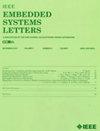Self-Tuning Model for Energy-Context Optimization in Perpetual Sensor Nodes Within IoT-Integrated Hydroponic Systems
IF 1.7
4区 计算机科学
Q3 COMPUTER SCIENCE, HARDWARE & ARCHITECTURE
引用次数: 0
Abstract
Hydroponic farming is a promising alternative to soil-based farming. However, it requires a precise control of the growth environment, which is hard to achieve with energy-constrained embedded systems. This letter presents an energy optimization technique for the continuous operation of energy harvesting-based hydroponics sensor nodes. The proposed technique is based on the self-tuning model, that dynamically adjust the duty cycle of the node, ensuring the autonomous operation of the Internet of Things system. The model can be programmed in a low-power microcontroller, allowing the decision-making process to reside entirely on the sensor node. Experimental results show that in the same time period, the self-tuning model allows物联网集成水栽系统中永久传感器节点的能量情境优化自调整模型
水培农业是一种替代土壤耕作的前景广阔的耕作方式。然而,它需要对生长环境进行精确控制,这在能源受限的嵌入式系统中很难实现。本文提出了一种能量优化技术,用于基于能量收集的水培传感器节点的连续运行。该技术基于自调整模型,可动态调整节点的占空比,确保物联网系统的自主运行。该模型可在低功耗微控制器中编程,使决策过程完全由传感器节点完成。实验结果表明,在相同的时间段内,自调整模型允许的数据传输量比统一的 5 分钟占空比多 3.5 倍,同时确保了存储设备中的最低电压水平。这种平衡使存储的能量足以进行连续监测,为水培系统提供了一种清洁、经济的永久供电替代方案。
本文章由计算机程序翻译,如有差异,请以英文原文为准。
求助全文
约1分钟内获得全文
求助全文
来源期刊

IEEE Embedded Systems Letters
Engineering-Control and Systems Engineering
CiteScore
3.30
自引率
0.00%
发文量
65
期刊介绍:
The IEEE Embedded Systems Letters (ESL), provides a forum for rapid dissemination of latest technical advances in embedded systems and related areas in embedded software. The emphasis is on models, methods, and tools that ensure secure, correct, efficient and robust design of embedded systems and their applications.
 求助内容:
求助内容: 应助结果提醒方式:
应助结果提醒方式:


